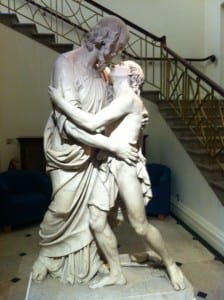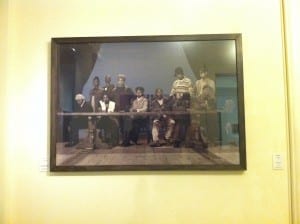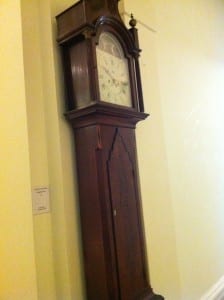During the development of our performance work, we explored our space through practical activities. This involved walking around Gallery 3, in different ways; firstly at our own paces naturalistically, then moving more mechanically to the sound of the gallery’s clocks, each time passing a small ball subtly between us only when our paths crossed.
Whilst carrying out this work, many members of the public came into our space as they visited the gallery. It was interesting to see how they reacted to what we were doing, as the gallery is a small space so everything in it is brought to an audiences attention. The members of the public not only became spectators of our work, but also became part of our work, as they walked amongst us. It raises the question of ‘who is the performer?’ as we were doing the same basic action of walking around a space, that the public were doing- albeit in a more structured way. This reminded me of the company Lone Twin and their work ‘Walk with Me’, in which their journeys were accompanied by local people who walked with them to various places. Obviously our work was confined to a much smaller and confined space.An interesting article I found during research states the following:
“It is a general term that the audience is co-present in a performance. The performer shares the same space, the same time and the same air with the present members of the audience. In a theatre piece these facts are similar but normally the actors have their “stage” or their character which they incorporate to distant themselves from the viewer. In performance art there is no distance: The performer is the subject and object of his or her own piece of art and also involves the audience into this multi-layered relationship.”
(Helge Meyer, Audience as Participant in Performance Art, 2009)
This demonstrates the difference between an audience in a more conventional theatrical experience to a performance art like site specific. With our work taking place in the Usher Gallery, our audience will be members of the public, some of whom will not be expecting us in the space. Some of the questions our group need to address include things like:
-
What kind of audience might there be on a Saturday in the Gallery? (more children? more families?) -This will change the reaction to our piece. Also if it becomes busier, then the space will become smaller for us to work with, which might pose a difficulty for us.
- How will the audience enter our space? – two doors into the Gallery. But close one off to make it even more claustrophobic?
- Will the audience be able to interact with our work? – are we manipulating the way they move around the space?
During our practical activity, some members of the public adopted a typical British approach of not acknowledging us at all. They accepted our movements in the space as ‘normal’, and focused their attentions solely on the gallerys display cabinets. Whereas others paused to observe us before entering the gallery, perhaps hesitant on whether they were allowed in, and intrigued by our silent exploration of the space.
It was interesting to observe how one lady, when stepping out of the gallery, raised her arms above her head, as if the gallery had contained her and she was now back in a space where she felt much more freedom. I asked several members of the public, how they felt when entering the gallery. Two ladies stated how they felt immediate discomfort because of the darkness of the room, and the low ceiling, that is so different to the rest of the Usher Gallery. However, they told me their attitude to the room soon changed with the longer they were in there. They accepted us into the space as though we were part of the display itself. What surprised me most about their response was how they didn’t notice the sound of the clocks, until I mentioned it and made them listen.
I learnt from these public responses, how each person has a different perception of a space and the things in it. Also duration seems to be an important part of the experience in that space, as the longer you are in there, then the more accustomed you come to its presence. As we add more performance elements to our piece and explore our ideas, I think we will begin to notice things in the space that initially we might have missed. Audience is vital and the sooner we identify how we want the audience to react or participate in our piece, then I think our work will become a lot more effective.
These are aspects which we can explore and develop as our research continues.
Works Cited
http://www.performance-art-research.de/texts/audience-as-participant_helge-meyer.pdf


 Left: Grandfather clock
Left: Grandfather clock 






